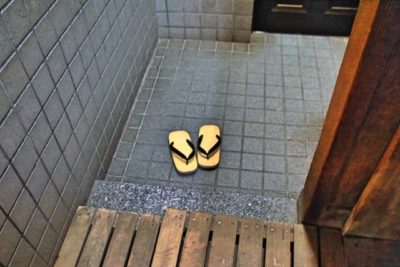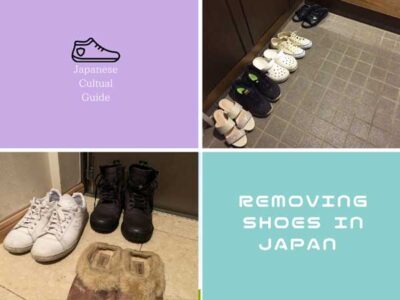There are many rules small and big when it comes to manners in Japan. One of those rules you are probably already familiar with; taking off your shoes before entering certain places. The rules surrounding this very clean Japanese custom are often very confusing for foreigners, though. Because there are quite a few strict rules. Let’s learn more about the idea of removing shoes. And we will also give some practical information that will surely come in handy on your next trip to Japan!

Japanese-style Living and Removing Shoes
Why are Japanese people so adamant about taking off their shoes before entering? It is because cleanliness and hygiene are important concepts in Japan. Most Japanese people will take off their shoes in their houses. So a Japanese home will very often have a designated place to leave shoes right after entering a home, even if there is not much space.
This small space right after the entrance is called a ‘genkan’. A genkan is usually a little lower than the main part of the house. It is the only place in the house you can wear your shoes. You are supposed to leave your shoes at the entrance and step into the room.
The floor of a traditional Japanese room is made of tatami (straw mat). Some rooms may have a floor made of wood, more often than not covered with carpets. In both cases, in a traditional-style room, there will be Japanese-type bedding called futon on the floor at night.
Zabuton
These futons are often rolled up again during the day so the room can be used for something else. When they have just a short rest, many people lie down directly on the tatami floor. As it is not too hard and comfortable for your body especially during the warm summer months during which tatami tends to stay cooler.
In a traditional living room, there are no high tables and chairs, but there is often a low table and cushions called zabuton. That means that both day and night, Japanese people live very close to the floor, making it even more important for the floors to be clean at all times. This is the main reason why Japanese people live without wearing shoes in the house. Whether you wear socks or are barefoot doesn’t matter, that will depend on your personal preference and whether your feet get cold easily.
History of Removing Shoes in Japan
There are two main reasons why Japanese people developed the clean custom of taking off their shoes. Even though nowadays there are quite a few especially younger people opt for a comfortable western-style bed and western-style floors. They often don’t even a single tatami room in the house. Firstly, Japanese people used to live in very small houses. There was not enough space to put big fixed furniture such as beds, tables, and chairs. How did they use their cramped quarters to live? They had a simple solution; using the same room for multiple purposes.
In the Edo period, normal families who lived downtown used to live in tiny one-room apartments of only around 8m2 big. During the daytime, this room was used as a living room. They put a low table on the floor with some cushions around it. The people may have worked using this table.
During meals, it becomes a dining room. They eat meals using the same table. In the evening after dinner, the room is used as a bedroom. The table is taken away to the corner of the room and spread the futon in the middle of the room. Then in the morning, they fold the futon and store them in the closet or just put them in the corner of the room.
Some even think that paper-folding art origami has developed in Japan. Because the Japanese people fold many things when they don’t use them. Futon, sensu (folding fans), and bath covers are some good examples of the type of stuff that gets folded and tucked away when not in use.
Boundary Between Outside and Inside
Another reason why they keep this custom is to separate the outside from the inside clearly. Many Japanese people have to work hard and experience various difficulties outside. But home should be a place where they can relax. Both the feet and the mind are relieved by taking off the shoes. The genkan (entrance) is both a physical and spiritual boundary for Japanese people.

Even though some houses may look like western houses, the residents most likely take off their shoes at the entrance and stay barefoot inside. Even if they don’t have a tatami floor inside. If a western person wonders why Japanese people take off their shoes, it is good for them to realize that conversely, Japanese people may wonder why many western people don’t remove their shoes when they enter their house. They think the house gets dirty when you walk in there with your shoes and wonder why some people don’t mind that.
Etiquette of Removing Shoes
If you come on a trip to Japan, you may have to remove your shoes at many places. For example, Buddhist temples, Shinto shrines, castles, folk house museums, Japanese restaurants, ryokan, and so on. When you book a Japanese cultural experience such as wearing kimono, seeing a tea ceremony, or creating calligraphy, you may also have to take off your shoes. Most Japanese cultural activities are held in a Japanese atmosphere, which often includes a tatami room. And by default, wearing shoes (or slippers) is never an option on tatami.
Many first-time Japan visitors wonder where the right location to take of their shoes is. If you visit temples in other Asian countries, after taking off your shoes it is OK to walk on the soil. But this is not the case in Japan. You are never supposed to walk on soil without shoes because your soles will get dirty which means that the floor will get dirty as well. This means that after taking off your shoes, you have to step inside directly from your loosened shoes. It may be difficult to know exactly where.
Wooden Floor Area
If you see a place that is a little higher than the soil, that means that it is already a part of ‘inside’. Meaning, you should not touch it with your shoes. So please be careful if you see a slotted wooden floor area like the one you can see in the picture above. This is called a ‘sunoko’, and it is considered a part of the inside of the house, so you should not take off your shoes there. If you make a mistake, the staff of the facilities may shout at you. It means this rule is very important in Japan.
You can leave your shoes at the entrance before stepping in unless there is a shoebox provided, in that case, you should put your shoes in the shoebox. Leaving your shoes before the entrance, the correct way to do this is to flip the direction of the shoes so that the toes point toward the outside. If you do this, it will mean that you can put your shoes on easily and start walking immediately upon leaving the building. When you are an important guest, the staff may change the direction of your shoes for you, but if you, for example, visit people at home it is a nice gesture to do this yourself.
Indoor Slippers
At the entrance of ryokan or a Japanese restaurant, they may prepare slippers for you. This is another thing that confuses many first-timers in Japan. But rest assured, these are special indoor slippers that are not supposed to touch any ground outside of the ryokan or restaurant. They are for walking along the corridors but are to be removed before stepping on tatami in your hotel room or restaurant private room.
And there there is a special mention for toilet slippers. As the name already says, this is a special set of slippers for the toilet. If these slippers are present in a toilet space, make sure to change into them. And even more important, never ever come out of the toilet and forget to remove these slippers. Obviously, they are dirty and many Japanese people will get a little heart attack if they see them anywhere outside of the toilet space.
Your Japan Tour
As seasoned Japan experts, we can help you create your perfect Japan tour including guides who can share cultural information. They can tell you about etiquette surrounding taking your shoes off so that you don’t have to worry about making mistakes. Contact us to start planning your unforgettable holiday to this fascinating country full of once-in-a-lifetime experiences, culture, history, nature, and delicious food!